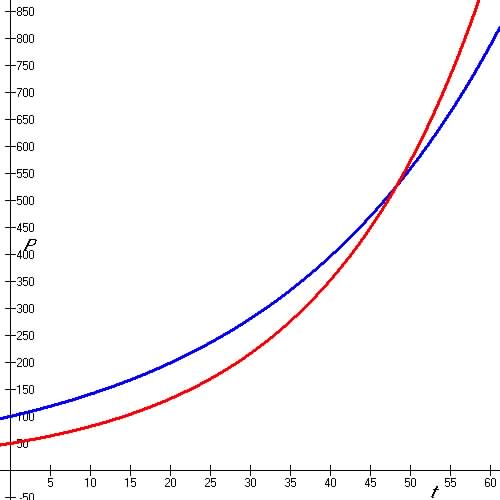
Department of Mathematics
Theory
by Example
Series
Exponential
and Logarithm Functions

Department of Mathematics Theory |
by Example Series Exponential and Logarithm Functions |
Question 1. When will the number of people infected with a certain
virus be reduced
to ½ its its current number if its is decreasing at a rate
of 0.3 % each day?, therefore,
r=0.003
Let Number infected with time be Pt, then ![]()
When number infected is ½ , Pt = ½ P0 =P0(0.997)t
Divide through by P0: ½ = (0.997)t
Take logs (ln) of both sides: ln ( ½ ) = t ln(0.997),
So ![]()
(check: P230.7=P0(0.997)230.7 = P0 x 0.5 = ½ P0)
Question 2. What will be the population of doves after 10 years if
the current population
is 61,000 and expects to grow exponentially at a rate of 0.005 %
each year?
Since exponential growth: Pt =P0 (1+r)t , r = 0.005 / 100 = 0.00005, t = 10
Pt =61,000 (1+0.00005)10 =61030.5 or 61,031
Question 3. The cost of tuition per year, C, for students attending
Ridgemount Community College increases at a constant percent rate (so exponential)
over a 4 year period since 1985. From the information shown in the table
below:
| Year, t | Number of Students, N | Tuition Cost per year for students, C, $ |
| 1986 | Not Available | 3,238.06 |
| 1987 | 867 | 3,270.44 |
| 1988 | Not Available | 3,303.15 |
| 1989 | 885 | 3,336.18 |
(a) Write a formula for Yearly Cost of Tuition, C, as a function of year, t since 1985.
(note t = 0 is 1985, t=1 is 1986) C=3206(1.01)t
Given t=2, C2 =3270.44 and t =4. C4 = 3336.18, So Ct=C0 (1+r)t
![]()
![]()
C0 = $3,206
Question 4. An investment grows at a rate
of 3% each year. How long will it take
the investment to double its value?
Let Investment with time be It, then![]()
When Investment doubles It = 2 I0 =I0(1.03)t
Divide through by I0: 2 = (1.03)t
Take logs (ln) of both sides: ln (2) = t ln(1.03),
So ![]()
(check: I23.45=I0(1.03)23.45 = I0 x 2 = 2 I0)
Question 5. What will be the population of doves after 5 years if
the current population
is 60,500 and expects to grow exponentially at a rate of 0.009 %
each year?
Since exponential growth: Pt =P0 (1+r)t , r = 0.009 / 100 = 0.00009, t = 5
Pt =60500 (1+0.00009)5 =60527.23 or 60,527
Question 6. Number of students, N, attending Ridgemount Community
College
increases at a constant percent rate (so exponential) over a 4 year
period since 1985.
From the information shown in the table below:
| Year | Number of Students, N | Tuition Cost per year for students, C, $ |
| 1986 | Not Available | 3,238.06 |
| 1987 | 867 | 3,270.44 |
| 1988 | Not Available | 3,303.15 |
| 1989 | 885 | 3,336.18 |
(a) Write a formula for Number of Students as a function of year, t
since 1985.
(note t = 0 is 1985, t=1 is 1986) N=850(1.01)t
Given t=2, N2 =867 and t =4. N4 = 885 function is: N(t) = N0 ( 1+r)t
![]()
![]()
N0 = 849 or 850 students
So N(t) = 850 ( 1.01)t
(b) State the percent growth rate and the Number of students in 1985.
Rate is 1.03 % and N(1985) is about 850
Question 7. When will a population growing at 2.5% each day doubles in size?
![]()
![]() 28.07
days
28.07
days
t = 28.07 days
Question 8. When will two populations be
equal in size if one population starts at 100 thousands
and grows each year by 3.5% and the other population starts at 50
thousands and grows each year by 5%?
![]() and
and ![]() both functions intersect in t = 48.17 years
both functions intersect in t = 48.17 years
 |
![]()
![]() Take ln of both sides:
Take ln of both sides:
![]() 48.17 years
48.17 years
Question 9. A radioactive substance decays exponentially to 1/3 its
original weight after 6 hours,
how much will be left after one day?
First determine the rate of decay, r or (1-r): let W = weight of substance
![]() W0 cancels out:
W0 cancels out:
![]() so
so ![]()
After 1 day or 24 hours:
![]()
Question 10. What is the interest gained on $50,000 on gold deposited
in a bank for 2 years
and compounding interest daily at an annual rate of 6% ?
![]() =$56.374.29
So interest = P(2) - 50,000 = $6,374.29
=$56.374.29
So interest = P(2) - 50,000 = $6,374.29
Question 11. A population size 2 years after it was observed is 70.93
millions and
74.67 millions after the 4th year. Assuming exponential growth write
a formula for
the population size P as a function of time, t in years since observed.
Exponential growth: ![]()
Find (1+r): ![]()
Find P0: Using P2: 70.83=P0(1.02675)2=P0(1.0542), P0= 67.19 millions
So Pt = 67.19 (1.02675)t